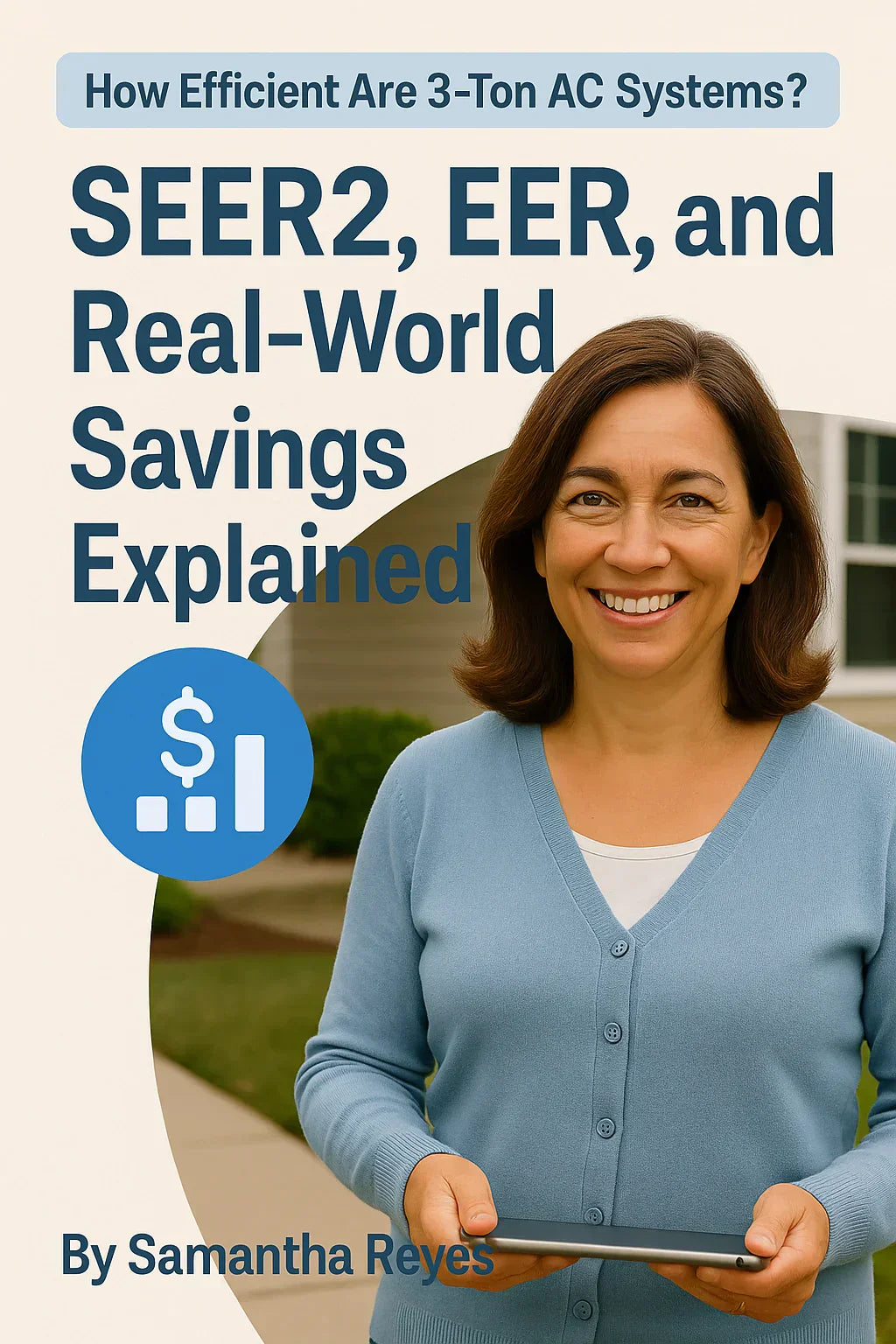🌬 Why AC Efficiency Matters More Than Ever in 2025
Hi there — Samantha here again.
When I bought my first home, I thought an air conditioner was just… an air conditioner. You turned it on, it blew cold air, end of story. But after years of paying steep summer electric bills, I realized there’s a big difference between a “works fine” unit and one that’s truly energy efficient.
In 2025, efficiency standards have changed (hello, SEER2!), energy prices keep climbing, and the way we evaluate AC systems has gotten more technical.
The good news? If you understand how to read those little yellow energy labels — and match them to your home’s needs — you can save hundreds of dollars every year without sacrificing comfort.
📊 Efficiency Basics: SEER, SEER2, and EER Defined
Before we compare models, let’s get our rating terms straight.
SEER (Seasonal Energy Efficiency Ratio)
-
Old standard before 2023.
-
Measures cooling output (BTUs) over a season divided by total energy used (watt-hours).
-
Higher = better efficiency.
SEER2
-
Updated test method mandated by the U.S. Department of Energy in 2023.
-
Accounts for higher external static pressure to simulate real-world duct conditions.
-
SEER2 values are about 4.7–4.9% lower than equivalent old SEER ratings.
EER (Energy Efficiency Ratio)
-
Measures efficiency at a specific outdoor temperature (usually 95°F).
-
Best for understanding performance in hot, peak-load conditions.
Quick Translation:
-
SEER2 = seasonal performance
-
EER = peak hot-day performance
🏷 What’s Considered “Good” for a 3-Ton AC in 2025?
| Tier | SEER2 Rating | EER | Typical Unit Type |
|---|---|---|---|
| Minimum Legal Standard (South) | 14.3 | 11–12 | Single-stage |
| Minimum Legal Standard (North) | 13.4 | 11–12 | Single-stage |
| High Efficiency | 16–18 | 12–13 | Two-stage |
| Ultra High Efficiency | 19–24 | 13–15 | Variable-speed inverter |
📈 How Ratings Translate to Real-World Savings
Let’s look at two real examples from my research in 2025.
Scenario:
-
Home size: 1,800 sq ft
-
Climate: Hot/humid (Louisiana)
-
Cooling season: 1,400 hours/year
-
Electricity rate: $0.14/kWh
| Unit | SEER2 | Annual kWh | Annual Cost |
|---|---|---|---|
| Standard Single-Stage | 14.3 | 4,000 kWh | $560 |
| High-Efficiency Two-Stage | 17.0 | 3,400 kWh | $476 |
| Variable-Speed | 21.0 | 2,750 kWh | $385 |
That’s a $175/year difference between the most and least efficient option. Over 15 years, that’s $2,625 in electricity savings — not counting rebates.
🌎 Climate Zone Impact on Savings
The hotter your summers, the more you’ll benefit from higher efficiency.
| Climate | Hours of Cooling/Year | Potential Annual Savings (14.3 → 18 SEER2) |
|---|---|---|
| Cool (Seattle) | 300 | $30 |
| Moderate (Chicago) | 750 | $75 |
| Hot/Dry (Phoenix) | 1,200 | $140 |
| Hot/Humid (Houston) | 1,500 | $175 |
🔍 Lab Ratings vs. Reality
That shiny yellow EnergyGuide label is based on standardized lab conditions:
-
Perfect duct sealing
-
Ideal refrigerant charge
-
No shading or debris around condenser
-
Thermostat set at a consistent temp
In the real world, performance is affected by:
-
Duct leakage (can cut efficiency by 20–30%)
-
Incorrect refrigerant charge
-
Poor airflow balance
-
Oversizing (short cycling)
⚙ Other Factors Affecting Efficiency
-
Compressor Type
-
Single-stage: Lowest efficiency, more cycling
-
Two-stage: Better humidity control, higher SEER2
-
Variable-speed: Best overall efficiency & comfort
-
-
Refrigerant Choice
-
R-32 often slightly more efficient than R-410A in the same system.
-
-
Thermostat Technology
-
Smart thermostats can cut cooling costs by 8%+ according to EPA Energy Star.
-
-
Maintenance Habits
-
Dirty coils, clogged filters, and blocked vents can all lower efficiency ratings in practice.
-
💵 Upfront vs. Lifetime Cost Trade-Offs
Let’s compare:
| Unit | SEER2 | Installed Cost | Est. Annual Cost | 15-Year Total (Equip + Energy) |
|---|---|---|---|---|
| Standard | 14.3 | $6,000 | $560 | $14,400 |
| High-Efficiency | 17.0 | $7,200 | $476 | $14,340 |
| Variable-Speed | 21.0 | $9,000 | $385 | $14,775 |
Surprise: The high-efficiency two-stage can actually be cheaper over 15 years than the standard model — even with a higher upfront price.
🏠 Samantha’s Experience with Efficiency Upgrades
When I swapped my old 13 SEER single-stage unit for a 17 SEER2 two-stage:
-
My July electric bill dropped from $195 to $165.
-
Indoor humidity stayed at a comfortable 47–49% instead of hovering over 55%.
-
The system ran longer but quieter, and the house felt more consistently cool.
In my climate (hot/humid), it took about 6 years to break even on the extra cost — and everything after that has been pure savings.
✅ How to Choose the Right Efficiency Level
-
Check your climate zone — hotter = more savings.
-
Plan your stay — if you’ll move in 2–3 years, skip the ultra-high tier.
-
Look for rebates — utilities often give $300–$800 for Energy Star models.
-
Balance with comfort — higher efficiency usually means better staging, humidity control, and quieter operation.
🧾 Efficiency Decision Checklist
✅ Know your local SEER2 minimum
✅ Compare kWh/year, not just SEER2 numbers
✅ Factor in climate-driven hours of cooling
✅ Ask for lifetime cost estimates
✅ Check for rebates & tax credits
✅ Ensure ductwork and installation quality
In the next topic we will read about: Maintenance Tips to Keep Your 3-Ton AC Running Like New







